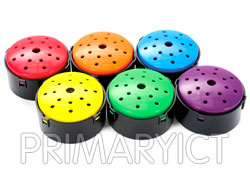Over summer 2013 we ran an additional research group called Extra Sensory Objects. The aim of the group was to develop tools to use during workshops with our Co-Researchers. The Sensory Objects team worked with two UROP students (Undergraduate Research Opportunity Students) who brought fresh ideas to the project. Kassie Headon from Art and Craig Whiffen from Systems engineering.
Find out more on the Extra Sensory Objects blog
We noted the things we would like to change about working with Micro controllers with Co-Researchers during workshops.
We considered how we could scale up the Micro Controller (Arduino) giving easier indication of where things needed to be plugged in.
How could we make the workshop process of collection in the museum, (for example of sounds), more simple and linked directly to how we trigger the sound with the micro controller?
During our Sensory Objects workshops at Speke Hall and in our Interactive Sculpture Workshops in the Art Dept at UoR we really enjoyed using Squishy Circuits to introduce the group to circuits. It was simple, tactile and there was something to enjoy no matter what your capabilties were. But moving on from this to using micro controllers such as Arduino was problematic as the Co-researchers needed so much support they lost control of the work. A similar problem was experienced with collecting sounds from museums to use with triggers in later workshops. We provided good quality recorders to capture sounds but the process of downloading the sounds to be used with micro controllers was complicated and had to be done on a computer so again the Co-researchers had to rely on others to achieve this part of the process. We wished we had simple way to collect sounds like these one press as units pictured below and then be able to connect them directly to the micro-controller.
speaking and recording units
We first discussed making a scaled up version of the micro controller we used in our Liverpool workshops Arduino but because the arduino gives so many options to control so many thinngs it is very quite complex. One of the group, Andrea Alessandrini, mentionedLittle Bits which is an open source library of electronic modules that snap together with magnets, we decided to explore Little Bits. Little Bits is made for children, it is colour coded and used magnets on units to join bits together so was very easy to use. We could control things like light, sound and motors. The Little Bits kit comes with a buzzer that we could control with various sensors. We wished there was a way to put our own sound content into Little Bits. Find out more on the Extra Sensory Objects blog

